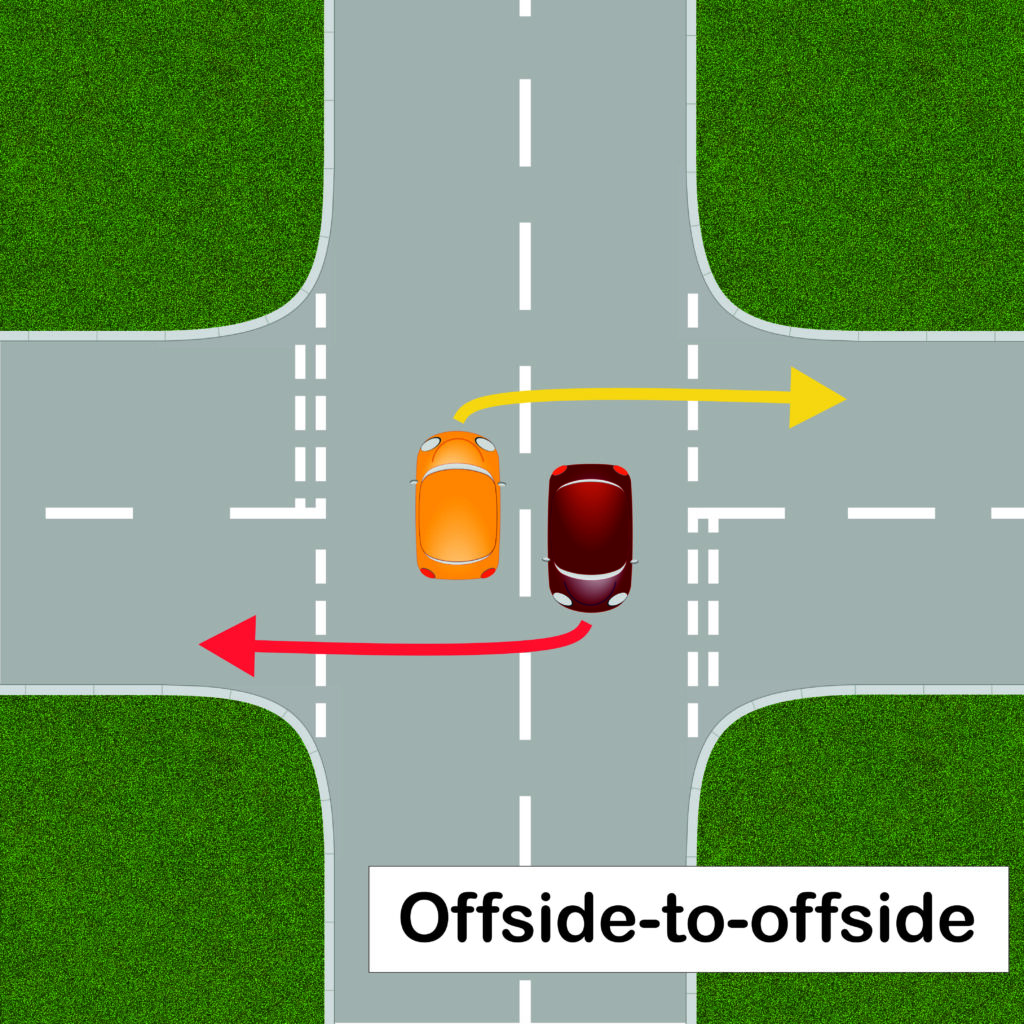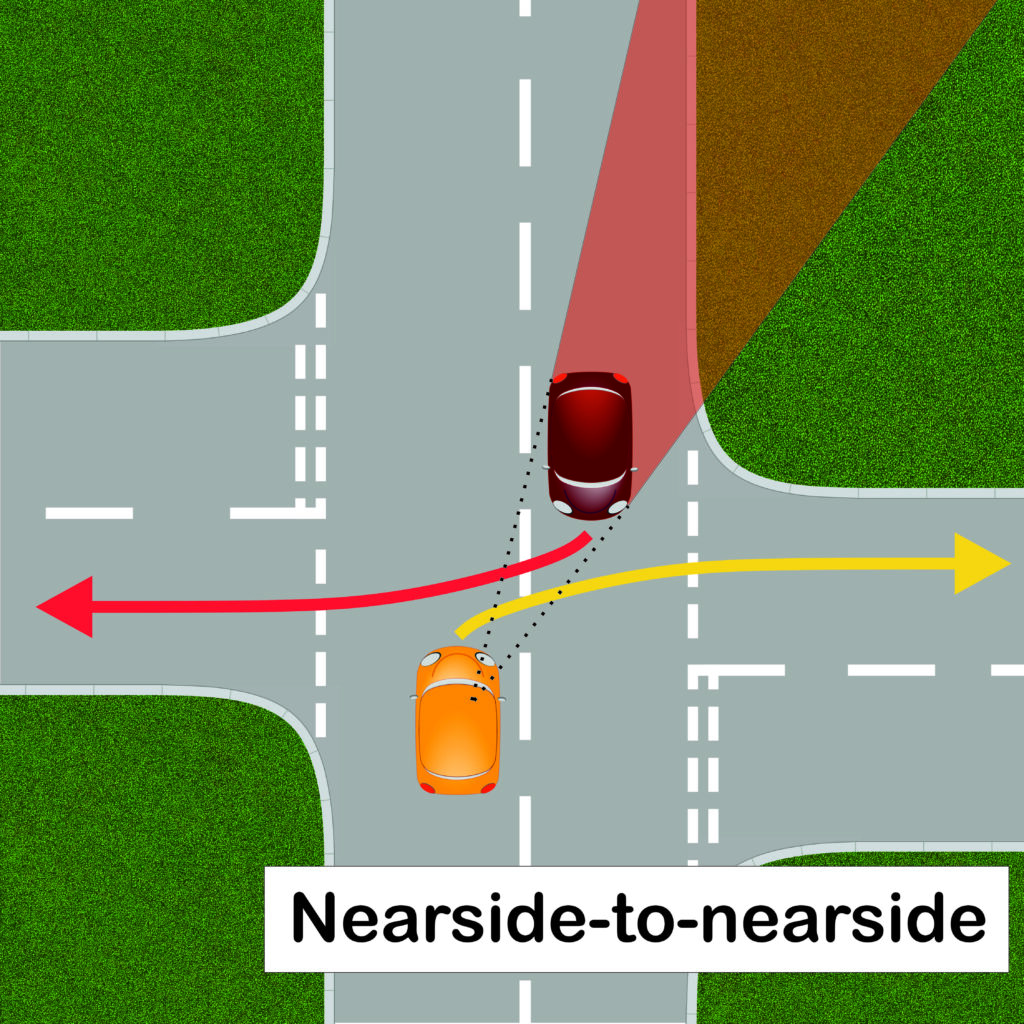Originally published in 2011, but updated periodically.
There seems to be a lot of confusion over how to turn right at crossroads when another vehicle is turning right from the opposite direction.
Driving: The Essential Skills (TES) – that’s the official DVSA guide to driving – says the following:
Turning right when an oncoming vehicle is also turning right
When two vehicles approaching from opposite directions both want to turn right, there are two methods that can be used. Either method is acceptable, but will usually be determined by
- the layout of the crossroads
- what course the other driver decides to take
- road markings
Turning offside to offside
The advantage of this method is that both can see oncoming traffic.
In congested traffic conditions, leave a space for approaching traffic to turn right.
Turning nearside to nearside
This method is less safe because the view of oncoming vehicles isn’t clear. Watch out for oncoming traffic hidden by larger vehicles. Motorcyclists and cyclists are particularly vulnerable, as they would be hidden by any type of vehicle.
Be ready to stop for oncoming vehicles.
Police control or road markings sometimes make this method compulsory.
Defensive driving
Try to make eye contact with the driver of the approaching vehicle to determine which course is best. Your speed should allow you to stop if the other driver pulls out across your path.
The Essential Skills
What’s the difference between nearside to nearside and offside to offside turning? Well, the nearside of the car is the one nearest the kerb, and the offside is the one farthest away from the it (the driver’s side). If you were turning offside-to-offside, this is what you’d be doing.

Note how each vehicle goes around the rear of the other, and so each has a completely clear view of the road ahead.
However, many road junctions are laid out so that offside-to-offside is impractical, or there might be a lot of traffic turning from the opposite side. This is where it would be necessary to use nearside-to-nearside instead. The positioning looks like this.

Here, the cars pass in front of each other, but that means there is a large blind spot created by the other vehicle(s), so you should always exercise caution if you are doing it this way. Only turn if you know it is clear, because cyclists and motorcyclists can still get past even on quite narrow roads.
As TES says, either method is perfectly acceptable, though one carries more risk.
Remember that every junction is different, and what works in one place will likely be different at another.
If you’re turning right from a side road at crossroads, and someone is doing the same on the other side, who has right of way? Officially, no one does. So, how do you deal with it at a junction where there are no marked turning areas?
The advice is to make eye contact with the other driver, but no one tells you how that translates into a solution. Fortunately, the other driver will do one of two things that effectively solve the problem for you. They will either pull out to try and ‘beat’ you (just let them get on with it), or they will flash their lights to tell you you can go first.
You ought to know that flashing headlights officially only means ‘I am here’, and nothing else. The problem is that if the other driver flashes you, other people will also see it and could assume it is directed at them. Don’t ignore it, but if you are absolutely sure it is directed at you, make certain there is nothing coming, don’t take risks, and take advantage of the opportunity. On your test, if you flash your lights at someone like this, you would probably get a serious fault for it. But if you respond correctly to someone flashing at you, you won’t be marked for it, because you’re not doing anything wrong.
An unwritten rule is that whoever got to the junction first takes priority, but you can’t assume everyone else will see it that way. Audi and BMW drivers certainly won’t.
Remember that the Highway Code says you shouldn’t beckon other drivers and road users. It doesn’t say you can’t communicate with them. Just don’t wave them forward – let them make their own decisions.
What happens when both cars are turning right at crossroads?
Neither car has priority. The options available to you are to turn nearside-to-nearside or offside-to-offside, as explained above.
When you reach the junction, make eye contact with the other driver. It isn’t a contest for you, so be prepared to give way if they treat it as though it is. You won’t lose anything by waiting for a few seconds while he gets out of the way. Obviously, if he gives way to you then you should check that it’s safe and proceed.
Can you flash your headlights?
Don’t flash your headlights at anyone on your test unless it is to alert them to your presence.
Many other drivers will flash their headlights to tell you they are giving way to you. It’s your responsibility to check that it is safe to go, and if you’re sure the flash was directed at you, just take advantage of it.
When you’ve passed your test, you probably will use your headlights for this occasionally. Just don’t get carried away and do it all the time.
Can you wave people through?
No. Never wave people through. It is dangerous.
But should you do these things on your test?
No. Don’t flash your headlights or gesture at people on your test. However, it is possible that a situation could arise where the only sensible thing to do is to flash your headlights or gesture to someone – even to beckon them.
Many years ago I had a pupil on test. He turned into a narrow road, and further down it was blocked by a bin lorry making bin collections, and the road wasn’t wide enough for two cars with all the parked vehicles along one side. He stopped. After a pause, he said to the examiner ‘I can’t get past’. The examiner replied ‘well, what would you do if you were here on your own?’ The pupil replied ‘well, I’d probably go up on the pavement to get past that way’. The examiner said ‘well, off you go’. He made sure it was safe to do it, and went by the lorry. And he passed.
You have to assess, be confident… and be safe.
Pupils don’t understand what offside and nearside mean.
Then educate them! It’s what they’re paying you for.
Offside to offside turning is stupid – people don’t do it.
No it isn’t, and yes they do. This ridiculous statement comes from poor quality instructor training. Sometimes it is road marked that you should do it. As TES says: either method is acceptable.
Marked crossroads are invariably nearside-to-nearside anyway.
No they aren’t! Just because you’ve never seen the other kind doesn’t mean they don’t exist. There are quite a few in Nottingham which are included in test routes.
This comment was picked up from a forum which was visiting this article when it was originally published, and it is simply untrue. As I’ve made clear, either method is acceptable and which one you use depends on:
- the junction involved
- road markings
- road layout (i.e. is it symmetrical or slightly skewed/staggered?)
- the time of day (i.e. how busy is it?)
- what other road users are doing (rightly or wrongly)
Offside to offside is unquestionably the safest method wherever it is possible to use it. Blindly trying to do nearside to nearside without understanding what you’re doing often means cutting corners, forcing others to stop or slow down, and taking needless risks. It points to ignorance of road rules and poor attitude.
Why should you check your mirrors when turning right?
One word: cyclists!
You ought to do a quick shoulder check, as well, just to be on the safe side. Trust me, not that long ago I saw a cyclist race up to a car which was turning right into Netherfield near the Colwick test centre, and turn right on his offside just as the car moved off. I’ve also seen them go round the nearside and do it.
To be fair, it isn’t just cyclists (though it is mainly them who are the problem). Motorcyclists (especially mopeds, which are just powered bicycles when you consider the idiots who usually ride them) will do it, and I’ve even had a van overtake (on the offside) when turning into a side road (I reported him to the police).
Who has priority at unmarked crossroads?
The short answer is no one does. Even at marked ones you can never be completely certain what others are going to do.
However, as a general rule for yourself, assume that if you are going to cross the path of anyone else, then you don’t have any sort of ‘priority’. In other words, if you are turning right at a crossroads, and someone on the opposite side wants to turn to their left or go straight ahead (and they might not be signalling even if they’re going left or right), don’t take any risks and just let them get on with it.
Make eye contact with the other driver. They may indicate with a gesture that they are allowing you to have priority – priority can be given, but never taken or assumed.
Driving: The Essential Skills (TES) says:
- if you’re turning right and the other vehicle is going ahead or turning left, you should normally wait for the other vehicle to clear the junction before you make your turn. Otherwise, you’d be cutting across their path
People come up with all sorts of ‘what if’ scenarios for this situation, but the simple answer is not to take risks, and not to assume other people are good drivers. For the sake of a few seconds, it is a minor inconvenience at most. Just give them priority (or let them assume they have it). That way, you are driving defensively even if they aren’t.